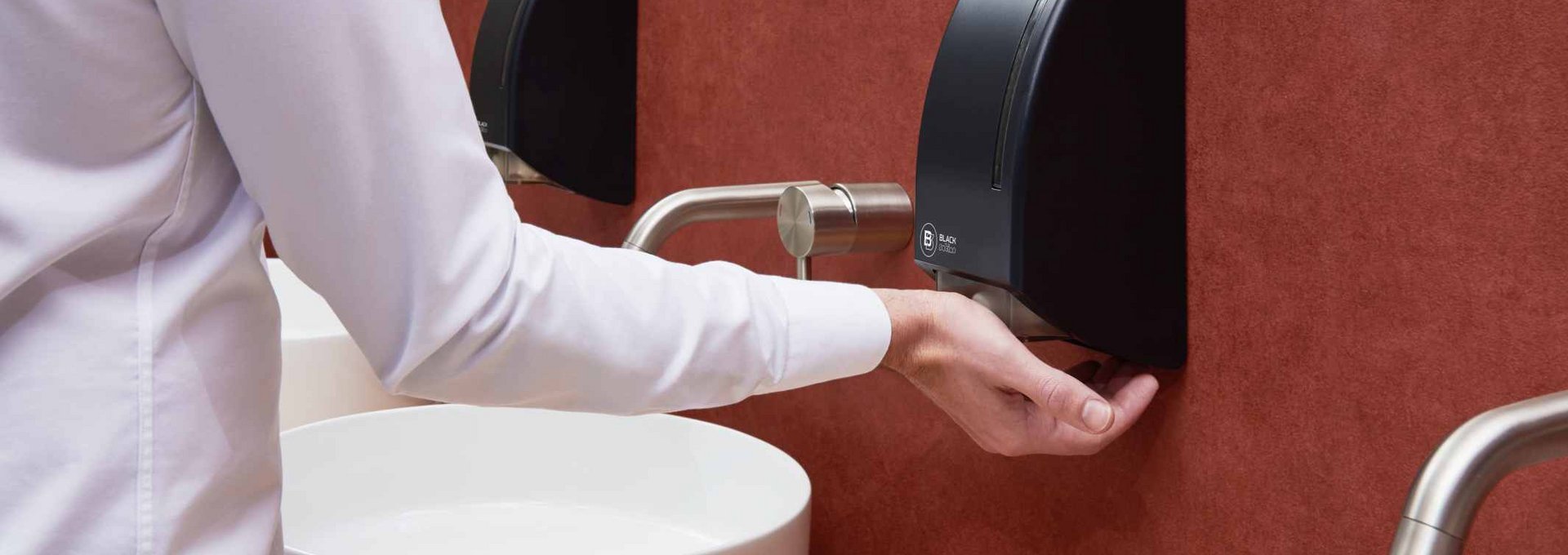
Find the answers to your questions:
Yes, the recycled cardboard boxes are Cradle to Cradle Certified, and the few products packaged in foil are made of fully recyclable PE.
Both Cradle to Cradle and the Blue Angel are eco-labels or environmental seals – i.e. labels with which manufacturers can verify the environmental friendliness of their brand or products.
The Blue Angel – its meaning
As far as hygiene paper is concerned, the Blue Angel focuses strongly on the raw materials used (100% recycled material) and product safety (e.g. particularly low use of harmful chemicals and a ban on bleaching with chlorine gas and optical brighteners – i.e. chemical additives used to intensively lighten the colour of the paper).
The products are tested for their efficiency. However, the label does not prescribe emission standards for pollutants in water and air or for CO2 emissions. There are also no specifications regarding energy consumption.
The Blue Angel is not a social label; working conditions during production are therefore not taken into account.
The Blue Angel is very well known in German-speaking countries, although less so internationally.
The criteria for the Blue Angel:
- Resource-saving manufacture of the products
- Use of sustainably produced raw materials
- Consumption of fewer resources during use and disposal
- Avoidance of harmful substances for the environment or health or the restriction of such substances to a minimum level
- Durability and repairability
- Recyclability
- Low emissions to soil, water, air; low noise levels
- High quality function
Cradle to Cradle – the meaning
Cradle to Cradle is a concept inspired by nature: the aim is a closed material cycle with absolutely no waste. As a consequence, products, processes, buildings and even entire towns and cities should be created that are safe for people, healthy for the environment and successful for the economy. Cradle to Cradle is a fundamental approach to a continuous and consistent circular economy.
A certification ("Cradle to Cradle Certified™") is awarded by the Cradle to Cradle Products Innovation Institute. It is only awarded to products made of materials that are harmless to health, environmentally safe and recyclable.
Cradle to Cradle does not simply compare products, but covers their entire value chain in its assessment and certification. This eco-label thus focuses on comprehensive sustainability and works towards the ideal state: at the end of a product life cycle, all raw materials used should be able to be returned to a production process, or else biodegraded.
The Cradle to Cradle eco-label is internationally known and accepted. The certificate is awarded in five levels, ranging from Basic to Platinum. To be awarded, a product must meet precisely defined minimum criteria for a level in each of the following five categories:
Cradle to Cradle – the categories:
- Material health
- Recyclability of the material in the technical or biological cycle (material reutilisation)
- Use of renewable energies in production (renewable energy and carbon management)
- Responsible use of water (water stewardship)
- Compliance with social standards (social fairness)
Is it possible to compare the Blue Angel and Cradle to Cradle at all?
What both have in common is that they are seals that accolade environmentally friendly products. For both labels, manufacturers must provide appropriate proofs or be independently audited.
However, their scope distinguishes the two eco-labels:
Cradle to Cradle is significantly more complex and holistically designed. It includes the manufacturing process, recycling, environmental emissions and social standards for a product – throughout its entire supply chain. Cradle to Cradle is a young concept that requires a new and innovative approach to products and manufacturing processes: already during the product's design stage it should be considered what it might become after the end of its life cycle. Ideally, Cradle to Cradle products do not generate waste but have their own material cycle or are biodegradable.
None of that, however, is the goal of the Blue Angel. The Blue Angel is first and foremost an important orientation aid for consumers. It compares specific products and distinguishes the more environmentally friendly variant among different products.
BlackSatino hygiene paper production utilises green electricity, and Gold Standard CO2 credits are awarded. With these Gold Standard CO2 credits, BlackSatino contributes to CO2 reduction through projects. The reduction achieved is used for compensation. The Gold Standard CO2 credits make BlackSatino CO2 neutralised.
100% green electricity is used produce BlackSatino dispensers and all fillings that are not paper (e.g. soap) This makes them CO2 neutralised.
BlackSatino was launched on the market in 2010 under the name Satino Black. At the time, black used to be the only dye (carbon black) available to give the dispensers made from recycled ABS uniform colour without harming the environment.
On 1 January 2020, Satino Black was renamed BlackSatino. The beginning of an even more sustainable story of growth and innovation of a strong brand.
Business customers can have BlackSatino hygiene products delivered by cleaning companies and specialist wholesalers, among others. If your current distributor’s range does not yet feature BlackSatino, simply contact us. We are happy to help.
The manufacturing process of BlackSatino is Cradle to Cradle Certified and CO2 neutralised. Thanks to exceptional environmental performance, BlackSatino contributes to a reduced ecological footprint.
The hygiene paper is also certified according to FSC (raw material recovered paper) and EU-Ecolabel (manufacturing process).
The attractive white and soft quality is achieved sustainably through the use of high-quality recycled paper. This is done in 3 steps:
- Recovered paper from offices is used as raw material. This paper is white and high-quality.
- All impurities are then removed from the recycled paper. That includes, for example, plastic, staples and ink, which are removed by sieving, among other measures.
- Finally, the cleaned paper is bleached. The additives used here are tested and recognised as Cradle to Cradle additives – and are therefore completely safe for people and the environment.
